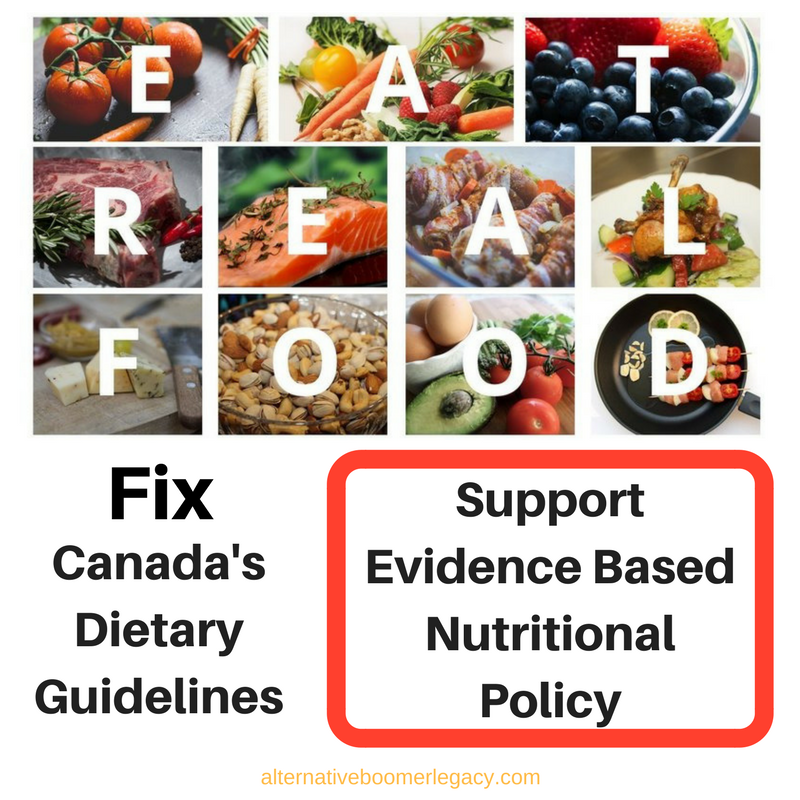do canada's dietary guidelines need fixing?Oh, yes, in fact they should have been fixed over thirty-five years ago! Over that time, there has been a sharp increase in chronic disease with ever rising rates of diabetes and obesity. Children are suffering in epidemic numbers with food allergies, asthma, diabetes, obesity, cancer, chronic bowel disorders, and autism spectrum disorders. Drastic change is needed to restore the Canadian diet to the traditional healing foods of our ancestors - clean, nutrient-dense real foods that sustain health and protect from disease. Sally Fallon Morell, founding President of the Weston A. Price Foundation and author of the best selling book, Nourishing Traditions isn't making an overstatement when she says, "We are receiving genocidal nutritional advice." The Standard American Diet (SAD - such an apt acronym!) guidelines are very similar to ours in Canada, so her comment is right on the money for what is wrong with our current guidelines, too. "WE ARE RECEIVING GENOCIDAL NUTRITION ADVICE"Sally Fallon Morell, President WESTON A. PRICE FOUNDATION® canada's current food guide |
 | what's wrong |
canola oil
"These studies all point in the same direction–that canola oil is definitely not healthy for the cardiovascular system. Like rapeseed oil, its predecessor, canola oil is associated with fibrotic lesions of the heart. It also causes vitamin E deficiency, undesirable changes in the blood platelets and shortened life-span in stroke-prone rats when it was the only oil in the animals’ diet. Furthermore, it seems to retard growth, which is why the FDA does not allow the use of canola oil in infant formula.19 When saturated fats are added to the diet, the undesirable effects of canola oil are mitigated. Most interesting of all is the fact that many studies show that the problems with canola oil are not related to the content of erucic acid, but more with the high levels of omega-3 fatty acids and low levels of saturated fats."
corn oil and Sunflower oil
"Safflower, Corn, Sunflower, Soybean and Cottonseed Oils all contain over 50% omega-6 and, except for soybean oil, only minimal amounts of omega-3. Safflower oil contains almost 80% omega-6. Researchers are just beginning to discover the dangers of excess omega-6 oils in the diet, whether rancid or not. Use of these oils should be strictly limited. They should never be consumed after they have been heated, as in cooking, frying or baking. High oleic safflower and sunflower oils, produced from hybrid plants, have a composition similar to olive oil, namely, high amounts of oleic acid and only small amounts of polyunsaturated fatty acids and, thus, are more stable than traditional varieties. However, it is difficult to find truly cold-pressed versions of these oils."
flaxseed oil
"Flax Seed Oil contains 9% saturated fatty acids, 18% oleic acid, 16% omega-6 and 57% omega-3. With its extremely high omega-3 content, flax seed oil provides a remedy for the omega-6/omega-3 imbalance so prevalent in America today. Not surprisingly, Scandinavian folk lore values flax seed oil as a health food. New extraction and bottling methods have minimized rancidity problems. It should always be kept refrigerated, never heated, and consumed in small amounts in salad dressings and spreads."
olive oil
"Olive Oil contains 75% oleic acid, the stable monounsaturated fat, along with 13% saturated fat, 10% omega-6 linoleic acid and 2% omega-3 linolenic acid. The high percentage of oleic acid makes olive oil ideal for salads and for cooking at moderate temperatures. Extra virgin olive oil is also rich in antioxidants. It should be cloudy, indicating that it has not been filtered, and have a golden yellow color, indicating that it is made from fully ripened olives. Olive oil has withstood the test of time; it is the safest vegetable oil you can use, but don’t overdo. The longer chain fatty acids found in olive oil are more likely to contribute to the buildup of body fat than the short- and medium-chain fatty acids found in butter, coconut oil or palm kernel oil."
peanut oil
"Peanut Oil contains 48% oleic acid, 18% saturated fat and 34% omega-6 linoleic acid. Like olive oil, peanut oil is relatively stable and, therefore, appropriate for stir-frys on occasion. But the high percentage of omega-6 presents a potential danger, so use of peanut oil should be strictly limited."
soybean oil
Confused About Soy?
Soy Dangers Summarized
- High levels of phytic acid in soy reduce assimilation of calcium, magnesium, copper, iron and zinc. Phytic acid in soy is not neutralized by ordinary preparation methods such as soaking, sprouting and long, slow cooking. High phytate diets have caused growth problems in children.
- Trypsin inhibitors in soy interfere with protein digestion and may cause pancreatic disorders. In test animals soy containing trypsin inhibitors caused stunted growth.
- Soy phytoestrogens disrupt endocrine function and have the potential to cause infertility and to promote breast cancer in adult women.
- Soy phytoestrogens are potent antithyroid agents that cause hypothyroidism and may cause thyroid cancer. In infants, consumption of soy formula has been linked to autoimmune thyroid disease.
- Vitamin B12 analogs in soy are not absorbed and actually increase the body’s requirement for B12.
- Soy foods increase the body’s requirement for vitamin D.
- Fragile proteins are denatured during high temperature processing to make soy protein isolate and textured vegetable protein.
- Processing of soy protein results in the formation of toxic lysinoalanine and highly carcinogenic nitrosamines.
- Free glutamic acid or MSG, a potent neurotoxin, is formed during soy food processing and additional amounts are added to many soy foods.
- Soy foods contain high levels of aluminum which is toxic to the nervous system and the kidneys.
So, what fats should we eat?
Butter is better for your brain!
- Cholesterol: The highest concentration of cholesterol occurs in the brain, where it plays an especially important role in memory formation. Seniors with the highest cholesterol levels have the best memory function. Cholesterol also plays a major role in regulating serotonin levels in the brain – low cholesterol levels are associated with depression, anti-social behavior and even suicide.
- Saturated Fats: The brain contains high levels of saturated fats, both in the cell membranes and in the mitochondria. Saturated fats are stable and don’t create damage in the brain like poly-unsaturated fats do.
- Arachidonic Acid: Eleven percent of your brain is composed of arachidonic acid (AA), a type of omega-6 fatty acids found exclusively in animal fats like butter. A supply of AA is critical to neurological development in the infant.
- Vitamin A plays a key role in vision and all sensory perception. Butter is an excellent source of vitamin A.
- Vitamin D is critical to neurological function and protection against depression. Butter provides vitamin D.
- Vitamin K supports neurological function and learning. Butter provides vit. K.
- DHA is an omega-3 fatty acids especially concentrated in the brain. Seafood is a good source, but butter provides it also.
- Choline is critical for the formation of glial cells. Butter is an excellent source.
For more information and references: https://www.westonaprice.org/health-topics/know-your-fats/why-butter-is-better/.
Health Canada is currently revamping our Food Guide. The enlightened folks in the recently formed group, 'Canadian Clinicians for Therapeutic Nutrition' have been working hard to get our upcoming guidelines based on sound science to prevent further unintended health consequences.
If you are a health care professional, please join the 'Canadian Clinicians for Therapeutic Nutrition (CCTN)' -- a group that is helping to put metabolic disease into remission with reliable nutritition advice. See their web page: ccfortn.ca and give a like to their facebook page: www.facebook.com/ccfortn/.
Thanks for the information and where would I find the reference materials used for the research? I would like to add more nutritional substantive evidence for my own research! Wonderful article!
Thank you, Lorraine. The information comes from fully referenced articles provided by the Weston A. Price Foundation (westonaprice.org). The links that I have provided should take you to those articles, where the references are listed at each article's end. Also, each WAPF Wise Traditions Journal is available online with a bevy of referenced material on all topics around nutrition - again available through the main page of WAPF. Happy researching!
What is EO Olive oil?
Hi Carol. I missed a 'V' there. EVO stands for Extra Virgin Olive Oil. A lot of WAPF'ers like the Kirkland brand from Costco, since it passed standards tests for extra virgin olive oil. Cheers, Linda
Of return cut become must. Operation defense drive three sometimes ever present. Phone audience sell reach civil than how.
Leave a Reply.
Author
Linda Morken, WAPFTM Volunteer Chapter Leader in Sooke, British Columbia, Canada
[email protected]




 RSS Feed
RSS Feed
